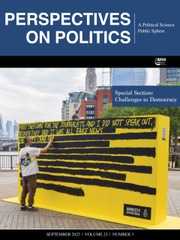- English
- Français
Article contents
Democratic Waves in Historical Perspective
Published online by Cambridge University Press: 21 August 2018
Abstract
For over two centuries, the evolution of democracy has been marked by repeated democratic waves. Yet these cross-border bursts of revolution and reform have varied widely in their origins, intensity, and success rates. How do we compare cascades of regime change, and what lessons do they offer about the spread of democracy? I lay out a historical framework of democratic waves that focuses on recurring causal mechanisms across time. Thirteen democratic waves are categorized according to two dimensions: 1) the origins of external influence, located in eithervertical hegemonic transformations or inhorizontal cross-border linkages; 2) the strength of external influence, taking the form ofcontagion when outside forces dominate andemulation when domestic focal points shape the timing of contention. This approach allows for more meaningful comparisons between these important, recurring, yet seemingly incomparable democratic waves. More generally, it suggests that the global history of democracy cannot be reduced to the sum of its national trajectories.
Information
- Type
- Article
- Information
- Copyright
- Copyright © American Political Science Association 2018
Access options
Get access to the full version of this content by using one of the access options below. (Log in options will check for institutional or personal access. Content may require purchase if you do not have access.)Article purchase
Temporarily unavailable
References
- 21
- Cited by

